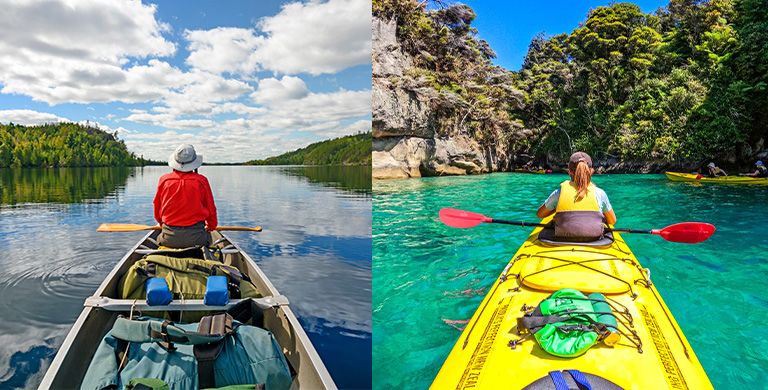
OUTDOOR LIFE
Be Here Now: Columbia’s Guide to Outdoor Meditation and Mindfulness
BY: NANCY BOUCHARD
“Climb the mountains and get their good tidings. Nature's peace will flow into you as sunshine flows into trees.”
John Muir
You don’t need a yoga studio or a mountaintop guru to shut down stress. Sometimes, the best way to find peace is to go outside. Sweat a little. Or a lot. Struggle a bit. Hike, run, ride, climb, paddle—watch the sun rise or set. Whatever gets you into that sublime zone where the mental chatter fades and your brain quits overthinking. Deadlines, missed appointments, trail bros silently judging your outfit? Forgotten. That’s flow. It’s you—fully present, centered, and powered by dirt, grit, and some Type 2 fun.

Nature and Mental Health
The idea that nature is good for your mental health isn’t new. Think Henry David Thoreau, who basically invented forest bathing, or John Muir, who considered the wilderness a sacred space—a place of peace, renewal, and self-connection. The Appalachian Trail was proposed to promote mental health and reconnect people with nature—and mental well-being—in the wake of the Industrial Revolution.
Now, more than 100 years later, the Tech/AI Revolution has further disturbed our sense of well-being. Noise—whether it’s 24/7 news, political chatter, soulless chatbots, manipulative algorithms or relentless social media. The result? Mental overload, a sense of losing control, and a growing disconnection from nature.
While the Industrial Revolution drained people physically through long, grueling work hours, the Tech/AI Revolution saps us both mentally and physically, fostering burnout, isolation, anxiety, and a constant pressure to compete in an always-on world.
Now, more than 100 years later, the Tech/AI Revolution has further disturbed our sense of well-being. Noise—whether it’s 24/7 news, political chatter, soulless chatbots, manipulative algorithms or relentless social media. The result? Mental overload, a sense of losing control, and a growing disconnection from nature.
While the Industrial Revolution drained people physically through long, grueling work hours, the Tech/AI Revolution saps us both mentally and physically, fostering burnout, isolation, anxiety, and a constant pressure to compete in an always-on world.
Keeping It Real: Meditation and Mindfulness for the Rest of Us
Meditation outdoors doesn’t require incense, gongs, pretzel poses or $160 yoga pants—just some time, comfy clothes, and a little curiosity. Whether you’re hiking, fishing, or parked under a tree like a woodland gnome, it’s surprisingly simple: find a spot, feel your feet—or butt--on the earth, breathe like you mean it, and let nature carry the rest. This isn’t about escaping life’s Sisyphean grind; it’s about hitting pause and catching your breath. That’s where mindfulness comes in—showing up fully to what’s actually happening without bolting for the mental exit. It’s noticing sunlight glinting off a leaf, the crunch of boots on dirt, or a dragonfly dive-bombing your fishing line. No spiritual mumbo jumbo—just paying attention to the here and now, clear-eyed and unfiltered. And while happiness or joy aren’t requirements, they often show up as easy guests when you finally relax enough to let them in.

11 Tips for Developing Your Own Outdoor Therapy Sessions
1.
Hike, Walk, Pause. Repeat.
Take time to pause. Find the perfect rock, lean against a tree, or stand still. Breathe deeply. Look around without judgment. Listen to wind, birds, or squirrel chatter. Let your surroundings ground you and banish anxiety into Mother Nature’s vault—she can handle it—then keep walking mindfully.
Take time to pause. Find the perfect rock, lean against a tree, or stand still. Breathe deeply. Look around without judgment. Listen to wind, birds, or squirrel chatter. Let your surroundings ground you and banish anxiety into Mother Nature’s vault—she can handle it—then keep walking mindfully.
2.
Outdoor Yoga as Moving Meditation
Yoga isn’t just physical—it’s meditation in motion. Join an outdoor session at a park, hotel, or retreat. Just find some flat ground, breathe deeply, and let your movement and breath sync with nature. You don’t need to know the difference between a Downward Dog and Wounded Tiger. Just stretch and focus on rhythmic breathing. Be calm.
Yoga isn’t just physical—it’s meditation in motion. Join an outdoor session at a park, hotel, or retreat. Just find some flat ground, breathe deeply, and let your movement and breath sync with nature. You don’t need to know the difference between a Downward Dog and Wounded Tiger. Just stretch and focus on rhythmic breathing. Be calm.
3.
Find Your Mantra
A simple phrase can keep your mind steady. Try one like “Every step counts” for tricky trails, or “I am perfect,” to bolster your morale. You can even borrow them from a favorite song. “Shake it off” and “Let It Be” work. One world-class hiker we know swears by “I won’t be eaten by a bear” for those long, backcountry tips wrought by self-doubt and uncertainty.
A simple phrase can keep your mind steady. Try one like “Every step counts” for tricky trails, or “I am perfect,” to bolster your morale. You can even borrow them from a favorite song. “Shake it off” and “Let It Be” work. One world-class hiker we know swears by “I won’t be eaten by a bear” for those long, backcountry tips wrought by self-doubt and uncertainty.
4.
Solace in Solitude
Colorado-based outdoor phenom, Steve Connolly, meditates for 15 minutes daily—whether he’s skiing, hiking, climbing, or simply lounging in nature. He uses apps like HeadSpace for outdoor-friendly meditations—and swears by wearing a hat with bug netting in summer. His tip? “Mosquitoes don’t care about inner peace.”
Colorado-based outdoor phenom, Steve Connolly, meditates for 15 minutes daily—whether he’s skiing, hiking, climbing, or simply lounging in nature. He uses apps like HeadSpace for outdoor-friendly meditations—and swears by wearing a hat with bug netting in summer. His tip? “Mosquitoes don’t care about inner peace.”

5.
Let Nature Be Your Zen Guide
Observe how trees sway or how a stream flows. Sync your breathing with the rhythm of the wind. Let nature guide your awareness rather than trying to force stillness. Dance to the bird songs, sway with the trees, or make up your own sun salutation. An impromptu jig or a Monty Python-inspired silly walk on the trail is empowering and fun. Like whirling dervishes, those mystical dancers who lose themselves in movement, let your body spin freely, embracing the rhythm of the earth and the energy of the moment—millions of Deadheads can’t all be wrong.
Observe how trees sway or how a stream flows. Sync your breathing with the rhythm of the wind. Let nature guide your awareness rather than trying to force stillness. Dance to the bird songs, sway with the trees, or make up your own sun salutation. An impromptu jig or a Monty Python-inspired silly walk on the trail is empowering and fun. Like whirling dervishes, those mystical dancers who lose themselves in movement, let your body spin freely, embracing the rhythm of the earth and the energy of the moment—millions of Deadheads can’t all be wrong.
6.
Barefoot in the Park
Kick off your shoes. Walk or stand barefoot in grass, sand, or soil. Feel the texture and temperature between your toes. It’s grounding—literally—and brings you right into the present. You don’t need to walk barefoot over hot coals to feel something real. Just keep tweezers handy.
Kick off your shoes. Walk or stand barefoot in grass, sand, or soil. Feel the texture and temperature between your toes. It’s grounding—literally—and brings you right into the present. You don’t need to walk barefoot over hot coals to feel something real. Just keep tweezers handy.
7.
Feed Your Mind
When you stop for a snack or drink, slow it down. Smell it, feel the texture, taste it. Appreciate it like a starving forager discovering your first nature-provided meal. Celebrate and enjoy the moment. Nourish your soul as well as your body. A mindful snack break is fuel for adventure, and a reset for your nervous system.
When you stop for a snack or drink, slow it down. Smell it, feel the texture, taste it. Appreciate it like a starving forager discovering your first nature-provided meal. Celebrate and enjoy the moment. Nourish your soul as well as your body. A mindful snack break is fuel for adventure, and a reset for your nervous system.
8.
Peace from Above
Remember lying in the grass watching clouds as a kid? You’re still allowed. Lie back, watch the clouds drift or constellations shift. Don’t narrate—just witness. It’s a great way to create inner spaciousness.
Remember lying in the grass watching clouds as a kid? You’re still allowed. Lie back, watch the clouds drift or constellations shift. Don’t narrate—just witness. It’s a great way to create inner spaciousness.

9.
Track Your Senses
Try a sensory scan: five things you can see, four you can hear, three you can feel, two you can smell, and one you can taste. Just avoid poisonous plant. It’s simple, grounding, and works almost anywhere.
Try a sensory scan: five things you can see, four you can hear, three you can feel, two you can smell, and one you can taste. Just avoid poisonous plant. It’s simple, grounding, and works almost anywhere.
10.
Ditch Your Phone
To truly connect, disconnect. Even just 15 minutes without screens can shift your whole headspace. Let nature fill the silence. Don’t look at the screen. Don’t even take the damn thing out of your pocket. Or better yet, leave it in your pack, car, or at home.
To truly connect, disconnect. Even just 15 minutes without screens can shift your whole headspace. Let nature fill the silence. Don’t look at the screen. Don’t even take the damn thing out of your pocket. Or better yet, leave it in your pack, car, or at home.
11.
Move Into the Flow State
You don’t have to sit still to meditate. In fact, some of the deepest mindfulness happens when you’re in motion—skiing, trail running, or scrambling uphill. As Dr. Tim Evens, a Bend, Oregon-based physical therapist, says, “Even people unfamiliar with mindfulness can appreciate the flow state that we experience in our favorite sports.” Whether carving turns on skis or bikes, or floating effortlessly on running trails, the goal is to silence the usual chatter in our minds. “We can use any meditation practice to become aware of the 'narrator' in our heads,” Evens adds, “and recognize that this background dialogue is malleable and doesn't define us. Through exercise and adventure, we drown out the chatter with the sensations of effort and struggle. If we're non-judgmental about the discomfort, the struggling narrator fades, and we're left with quiet peace.”
You don’t have to sit still to meditate. In fact, some of the deepest mindfulness happens when you’re in motion—skiing, trail running, or scrambling uphill. As Dr. Tim Evens, a Bend, Oregon-based physical therapist, says, “Even people unfamiliar with mindfulness can appreciate the flow state that we experience in our favorite sports.” Whether carving turns on skis or bikes, or floating effortlessly on running trails, the goal is to silence the usual chatter in our minds. “We can use any meditation practice to become aware of the 'narrator' in our heads,” Evens adds, “and recognize that this background dialogue is malleable and doesn't define us. Through exercise and adventure, we drown out the chatter with the sensations of effort and struggle. If we're non-judgmental about the discomfort, the struggling narrator fades, and we're left with quiet peace.”
For your next outdoor adventure, bring along Columbia apparel and footwear for a comfortable, relaxing experience.



